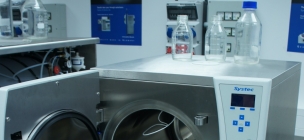
8 Household Items That Can Cause Danger to Your Home Jul 31, 2020

Tips for Making Sure Your Exterior is Storm Proof Jul 11, 2020

When Do You Need a New Garage Door Jul 11, 2020



5 Things You Should Know About Boiler Grants Jun 22, 2020


Benefits of Buying High Quality Portable Generators Apr 13, 2020




How does the steam sterilization process work? Nov 20, 2019

How does the steam sterilization process work?
Nov 20, 2019 07:29

Steam sterilization represents cutting-edge technology in decontamination. Despite being a highly modern solution in medical waste management, its origins go back as far as 1679, when a French physicist invented the first prototype, which was then called a “steam digester” instead of its more widely known name of “steam sterilizer”. Another synonym for this pressure cooker-like machine is “autoclave”: a highly effective instrument used in hospitals, bio labs, pharmacies, clinics, and other medical facilities around the world.
The benefits of steam sterilization
The four main benefits of this decontamination method are crystal clear: it is a cost-effective, safe, environmentally friendly, and efficient way to sterilize hospital and other medical equipment. The advantages compared to other forms of sterilization lie in the speed and the productivity of the autoclave, especially when handling moisture and heat stable tools.
So what can you put inside a steam sterilizer? Among other things, you can use it for medical equipment like implantable medical devices, surgical instruments, and surgical linens. While it is certainly a user-friendly device, considering the task this machine has to handle, the staff of CSSDs (Central Sterile Service Departments) should always follow the user instructions such manufacturers provide (like with Celitron’s autoclaves).
Nonetheless, steam sterilization has proven many time to be a reliable, and consistent way to handle medical equipment at all kinds of facilities.
The 3 steps of the steam sterilization process
Basically, the process is done by using high-pressure, saturated steam to sterilize medical equipment in need of decontamination. The power of the stream plays a key role here, as it enhances the properties of the heat that can destroy microorganisms.
The steam sterilization process works by cycles that consist of three phases: these are conditioning, exposure, and exhaust.
1. Conditioning
This is what happens at the start of each cycle. Gravity displacement in autoclaves first removes the air from the chamber of the machine, and then the tools put inside are heated to the sterilization temperature recommended by the manufacturer. Dynamic Air Removal methods can also remove the air from the chamber of the autoclave.
2. Exposure
After the heating process is done, the items inside are exposed to high-pressure steam. The temperature and time of this phase should also follow user instructions carefully.
3. Exhaust
Also known as the drying or cool-down phase. A vacuum helps remove the steam and release the pressure inside the chamber, so that the tools inside can come out dry.
Always remember that proper maintenance also plays a key role in the success of the steam sterilization process!

A well-designed workspace is more than just a place to get things done—it’s an environment that influences productivity, comfort, and even creativity. Whether you’re setting up a home office, launching a startup, or upgrading a corporate workspace, choosing the right Brisbane office furniture can make all the difference. Read more
APPLIANCES
furniture
Mar 17, 2025 22:33

Warm tones of Cozy Vibe and rustic wall art
Something happy about this cozy home. From cozying up with a blanket as the temperature drops to sitting in the sunlight while enjoying your next cup of coffee; a warm and inviting atmosphere feels like your safe haven. There is one of the simplest and most effective ways to achieve this, too, which is to use warm tones and rustic wall art in your decor. Besides, these elements are other character brims and will offer your space the comforting, homey touch. If you’d like to bring those cozy vibes home, here some ways you can use warm colors and rustic wall art to create a cozy atmosphere. Read more
Something happy about this cozy home. From cozying up with a blanket as the temperature drops to sitting in the sunlight while enjoying your next cup of coffee; a warm and inviting atmosphere feels like your safe haven. There is one of the simplest and most effective ways to achieve this, too, which is to use warm tones and rustic wall art in your decor. Besides, these elements are other character brims and will offer your space the comforting, homey touch. If you’d like to bring those cozy vibes home, here some ways you can use warm colors and rustic wall art to create a cozy atmosphere. Read more
APPLIANCES
Jan 31, 2025 10:35

A home that’s cozy yet curated is an art form in itself and what more beautiful way than mixing modern and vintage wall art for an eclectic decor style. When mixing these opposing aesthetics together, they can create depth, character and timeless quality to your space. But, it’s a matter of finding the right balance and that takes careful planning. In this guide you are going to learn how to use your historical native skills, and put them into a lesson that is more modern but still vintage wall art. Read more
APPLIANCES
Jan 31, 2025 10:29
Copyright © Fooyoh.com. All rights reserved. User Agreement | Privacy Policy | Contact us
| Advertising
| About us
| Careers














































